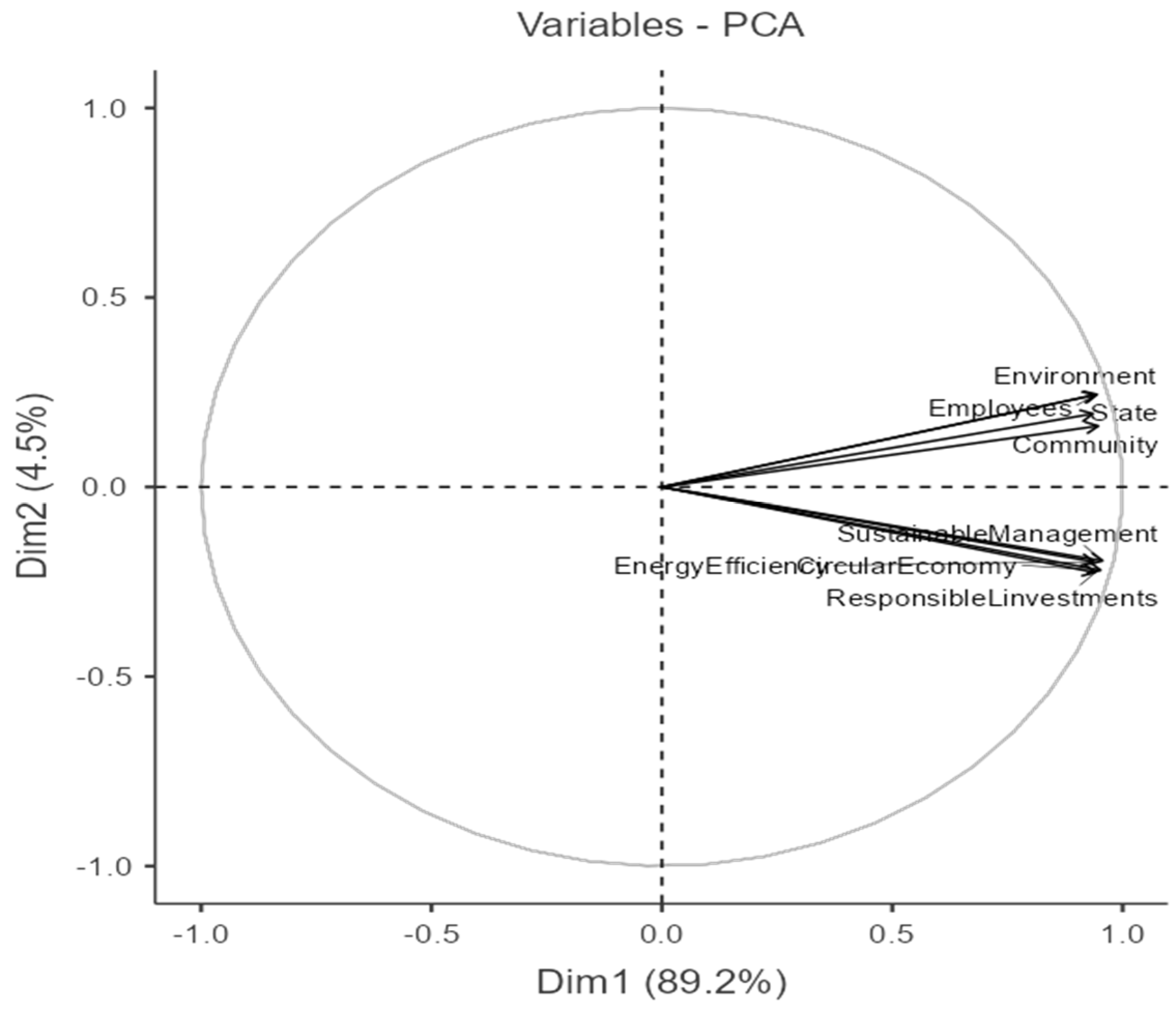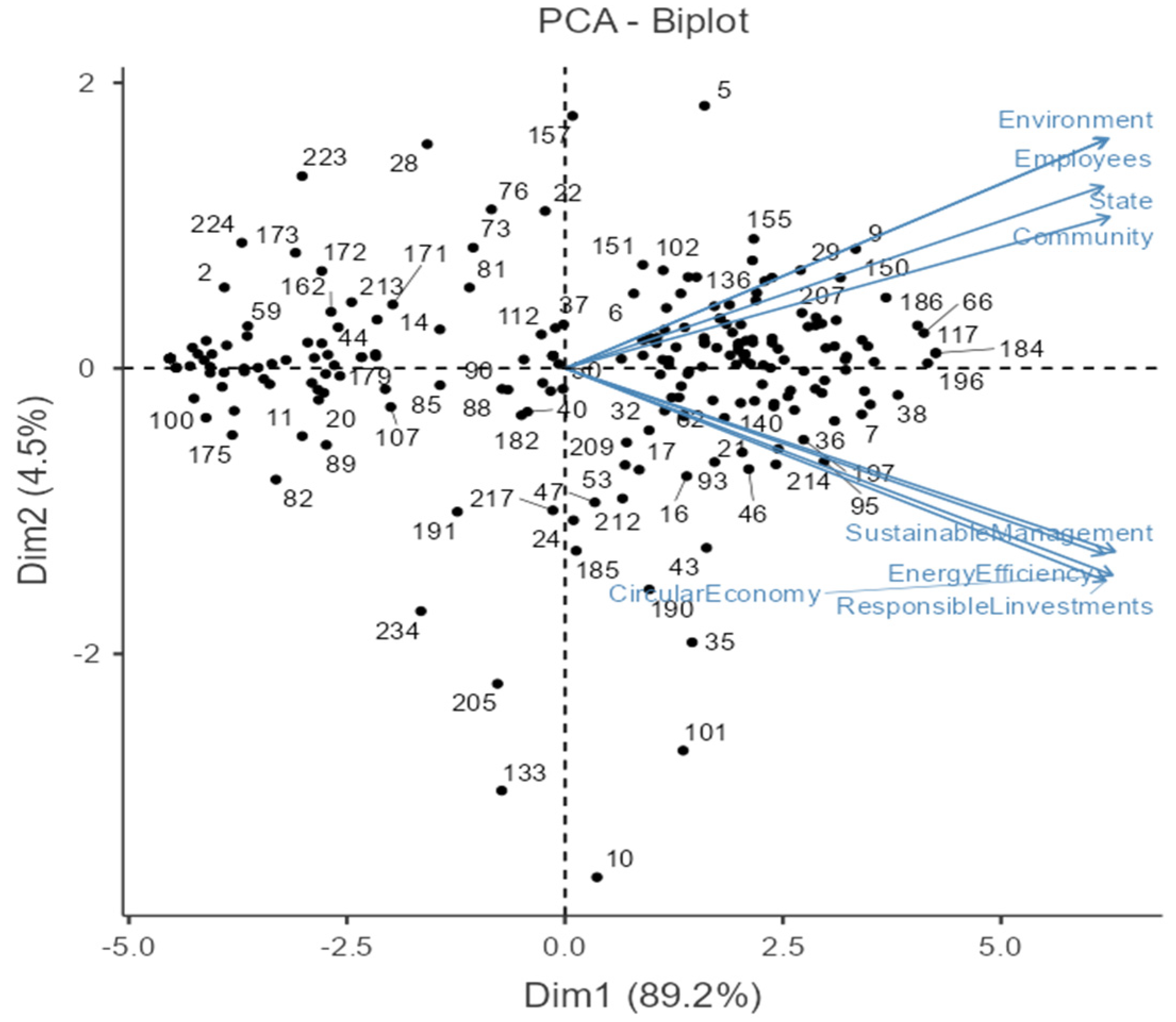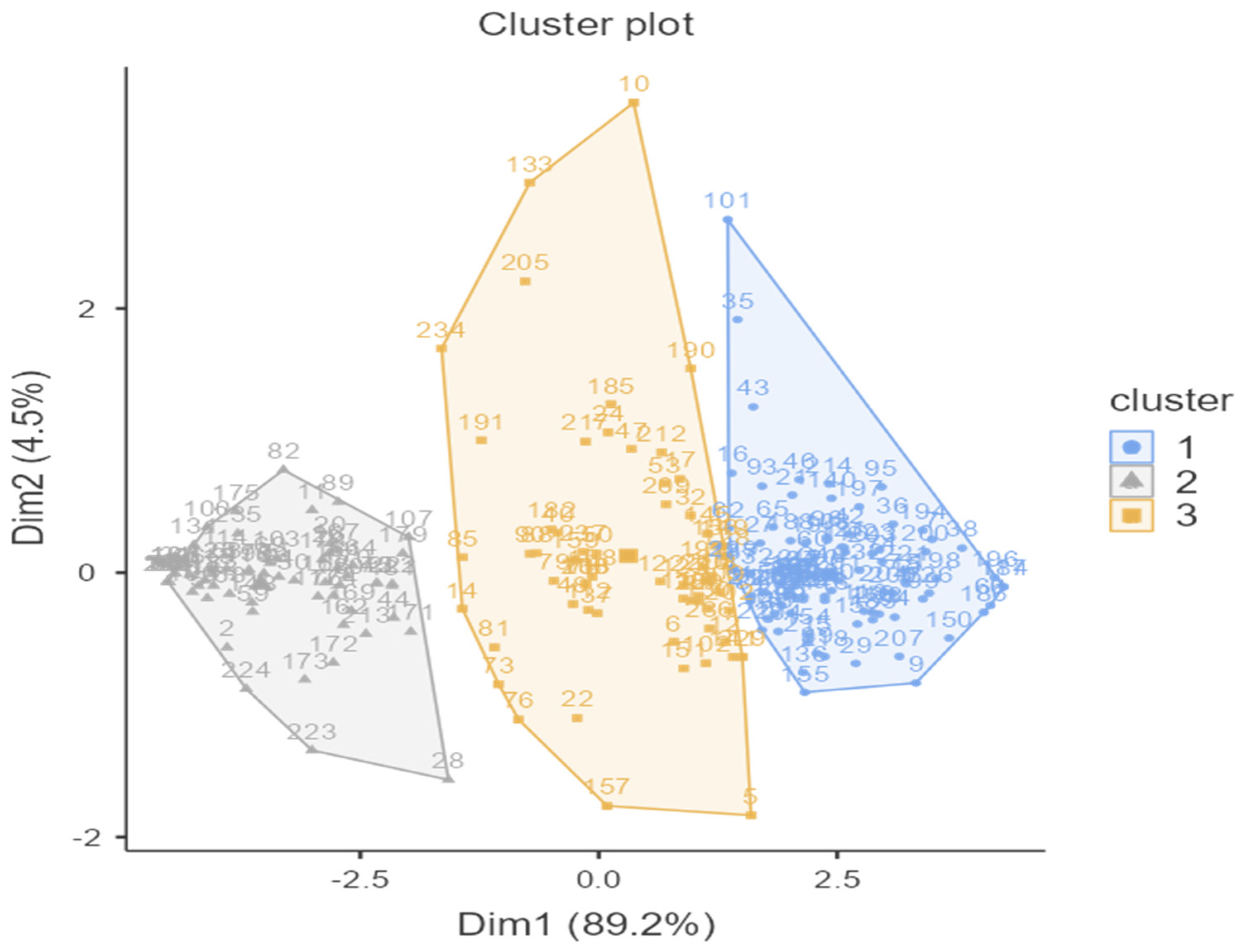The green economy is one of the global strategies used to address modern society’s economic and environmental crises. In the early years of economics as a science, except for the first work of the French physiocrats (1758), economists showed no interest in the relationship between the economy and nature. However, in the 1970s, this relationship became relevant again with the publication of the Club of Rome report, which started a “pessimistic” trend by pointing out the existence of biophysical limits to growth (
Meadows et al., 1972). An optimistic current soon emerged, marked by the belief that technology and markets could quickly resolve the conflict between economics and nature, and led to the discovery of the collection of essays,
A Response to Global 2000 Report (
Simon & Kahn, 1984). The “possibilist” movement aims to integrate economic models that allow economic growth compatible with sufficient conservation of nature to guarantee an adequate standard of living in the future (
Tolkachev et al., 2023). The concept of harmonious development of economy and society is important for its concept of sustainable development, which ignores the short-term profits of enterprises and strives for greater profits in the future. The 1987 Brundtland Report, which popularized the concept of sustainable development, framed the “possibilist” trend and proposed the idea of a green economy in this context.
Etymologically, (
Chaban-Garcia & Hidalgo-Capitan, 2023) define the green economy as an economic model to improve human well-being and social justice, reduce carbon emissions, increase income, create jobs, promote energy efficiency and resource use, and stop the loss of biological diversity and ecosystem services (
Batista et al., 2021). From this perspective, a green business must offer high value to consumers. It must also evoke an emotional response in consumers, which presupposes brand credibility or its ability to deliver the promised benefits. Most importantly, environmentally friendly principles must be embedded in all areas of a company’s existence and activities (
Alexandrova et al., 2020). The economic activities of companies are causing enormous damage to the environment, giving rise to the concept of sustainable development and strict requirements for environmental protection, which link all economic issues and relationships with corporate social responsibility (
Programa de las Naciones Unidas para el Medio Ambiente & Oficina Regional para América Latina y el Caribe, 2012) The green economy improves human well-being and social equity while significantly reducing environmental risks and ecological obstacles. It is low-carbon, resource-efficient, and socially inclusive (
Dominguez et al., 2020). Furthermore, the transition to a green economy differs in each country because it depends on the specific configuration of natural capital (i.e., extending the economic concept of capital to environmental goods and services). Natural resources such as forests, lakes, wetlands, and river basins are important parts of natural capital at the ecosystem level and their relative level of development (
Campos, 2010). In 21st-century business development and corporate social responsibility, it is crucial to examine the strategies and methodologies employed by leading organizations focused on renewable natural resources, such as the efficient use of fossil fuels, water, land, and vegetation essential for the lives of all species.
In Mexico, there are manufacturing sectors that generate high levels of pollution, such as petrochemicals, chemicals, paper, petroleum, and base metals, among others. In fact, this sector represents one of the economic activities with the highest costs due to the depletion of natural resources and the deterioration of the natural environment. Faced with these challenges, numerous companies in Mexico have begun to adopt more sustainable practices, such as the application of green technologies, energy efficiency, recycling materials, and the implementation of environmental management systems. Furthermore, through Corporate Social Responsibility, entities are incorporating policies to reduce their ecological impact and contribute to safeguarding the environment (
Ebisi et al., 2025).
3.1.5. Diamond Theory of Green Economy in Corporate Social Responsibility
Based on the concepts presented in the review of the literature on the green economy and after a detailed study of primary sources, the diamond theory of the green economy is proposed within the framework of CSR. The researchers develop and adopt this theory as a new theoretical framework in the field.
The green economy diamond is a conceptual model that provides companies with a framework for integrating environmental sustainability into their CSR strategies, providing companies with a structured framework for integrating sustainability into their CSR. By focusing on technological innovation, regulation, consumer demand, and sustainable financing, companies can improve their environmental impact, strengthen their market position, enhance their reputation, and improve their long-term sustainability. This approach benefits the company and contributes to the well-being of society and the planet. It is consistent with global business development objectives.
Within the framework of green economy theory, this model not only promotes efficient resource use and the reduction of negative impacts but also fosters economic growth that respects natural capital. Incorporating these concepts into CSR involves more than simply complying with regulations or carrying out isolated philanthropic initiatives; it involves transforming business models toward development that is sustainable, inclusive, and regenerative.
In this way, the green economy diamond not only helps boost companies’ competitiveness and corporate image but also aligns business activities with the Sustainable Development Goals (SDGs) and other global frameworks focused on sustainability. This comprehensive approach benefits companies by allowing them to anticipate emerging risks and opportunities, as well as society as a whole by fostering a more equitable, resilient, and environmentally friendly economy. The green economy diamond encompasses the following:
This is the development and application of technologies that reduce environmental impact, such as energy efficiency, renewable energy, and environmentally friendly products. Companies that invest in these technologies reduce operating costs, improve their efficiency, and decrease their carbon footprint, demonstrating their commitment to sustainability and improving their reputation. According to
Licandro et al. (
2024), the significant number of MSMEs in Latin America makes it essential to recognize the variations in how R&D activities are carried out depending on the company’s size. Large companies, due to their superior financial, organizational, and technological capacity, tend to carry out R&D more frequently and systematically. On the other hand, MSMEs face greater obstacles to carrying out these types of activities due to limitations in resources, access to financing, specialized personnel, and management (
Bergset, 2015). This means that in some cases, CSR is not seriously applied or is not a more effective way of promoting a green economy. Thus, climate change and new technologies are fostering greener business strategies. Companies are incorporating sophisticated studies to assess sustainability, adapting to regulations such as carbon taxes, and opting for green technologies to adapt to the regulatory and competitive environment.
- 2.
Environmental regulations and policies are an essential aspect of the green economy in the CSR strategy:
Regulations include laws, rules, and international agreements that promote environmentally sustainable business practices and penalize environmental damage. This paper analyses the impact of environmental regulations and policies on CSR and the benefits companies can obtain from complying with these regulations.
- 3.
Consumer awareness and demand:
These are essential components of the green economy diamond and play a crucial role in a company’s commitment to CSR. Companies can use these trends to improve their sustainability and competitiveness by developing sustainable products and services, communicating transparently, educating and engaging consumers, and collaborating with other stakeholders. The company’s ability to meet consumer demands for responsible business practices benefits the company, the environment, and society.
- 4.
Sustainable financing:
Financing the green economy diamond requires the resources needed for companies to implement and scale their sustainability initiatives. Leveraging green bonds, responsible investment funds, sustainability-based loans, and sustainable venture capital can help companies finance green projects, reduce financing costs, improve their reputation, and promote innovation. This approach benefits the company and significantly impacts the environment and society, supporting global sustainable development goals.
According to
Stein and Wagner (
2019), Latin America and the Caribbean are clearly among the regions where venture capital investments are growing most rapidly, along with sub-Saharan Africa. In Latin America and the Caribbean, the value of venture capital investments grew at an annual rate of 31.2%, well above the 9.7% in East Asia and the Pacific (including China) and the 7.6% per year in South Asia, including India. Over this period, levels in developed regions remained virtually constant, if measured according to the log-linear trend (0.5% annual growth in industrialized countries, excluding the United States, and a 0.1% decline in that country). China and India tend to invest more than other countries in general, not just in venture capital investments. For example, gross fixed capital formation stood at around 21% of GDP in the Latin American economies in the sample. The investment rate in China was double, reaching almost 45% of GDP, while in India, the rate was somewhere in between, around 33% of GDP. This shows that overall, there is a difference in investment, but the tenfold difference in the venture capital-to-GDP ratio detected is significant.
From the above, it can be inferred that Porter’s Diamond theory, as it relates to venture capital, describes how an enabling national environment can incentivize the implementation of green technologies in SMEs. Venture capital functions as a structural enabler, optimizing factor conditions, boosting demand, establishing connections with supporting industries, and promoting sustainable competition, thereby driving green economy innovation. It contributes to understanding how favorable or adverse circumstances are created for SMEs to incorporate sustainable technologies into their processes and business models.










